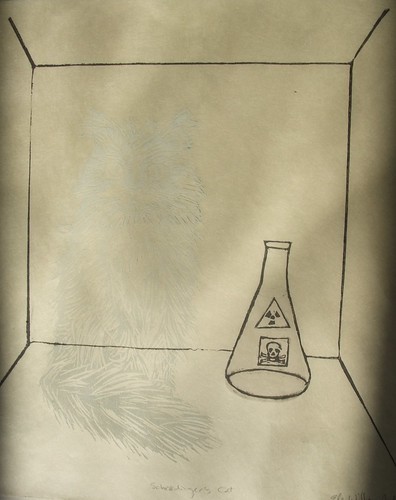


Is Schrödinger's cat in the box, or not? It depends on when you look at this linocut! This colour-changing thermochromic block print shows the famous thought-experiment of renown quantum physicist Erwin Schrödinger (who would never hurt a real cat!). Both the cat in blue and the poison in pink will disappear when the print is exposed to heat.
In struggling to fully explain the strangeness of the quantum world, which can only be described in terms of probabilities and wave functions, Schrödinger suggested a sort of metaphor, at the size of every day things - the scale of classical physics as we know it. He imagined a cat in a steel box with a vial of poison which might be opened if, and only if, a radioactive decay occurs. In one half-life of the radioactive material, there is a 50:50 chance that the material has decayed or not. So, if the box is closed, and we cannot see within, we can only describe the state of the cat in terms of probabilistic wave functions. After one half-life, we would be forced to describe the contents of the box as the sum of the half likelihood of a live cat and the half likelihood of a dead cat. It is as if, to the outside world, there exists both a live and dead cat.... until, one opens the box and looks. Then we know we either have not yet had the radioactive decay and subsequent release of poison, so the cat is fine, or the radioactive material has decayed and the cat is no more. So, what's so special about looking in the box? Does the wave function "collapse" onto one of these two possibilities? Does the universe split into one in which the cat lives and one in which the cat does not, as in the many-worlds interpretation of quantum mechanics? I tend to side with Niels Bohr whose Copenhagen Interpretation of quantum mechanics says, as all experimentalists know, unless you observe something you cannot determine its state. However, physics cannot answer this question! We can determine the probabilities only, we cannot say why. But that's okay. Paradox is delicious.

This is one print in an edition of 10. Each print is made with the box and vial printed in normal, silver block printing ink. The cat and poison are printed using thermochromic powder and block printing medium so when heated above 30°C (86 F) then they turn colourless and disappear. Thus, as in the thought experiment, you don't know whether there is a cat in the box without looking at the print. Each print is 12.3 by 12.5 inches (31.2 cm by 31.8 cm) and made on Japanese kozo (or mulberry) paper.
This print is one of a series of 'Imaginary Friends of Science', including Maxwell's Demon, Laplace's Demon and Descartes' Demon. It is also one of a collection of thermochromic prints which include a portrait of Louis Pasteur (with disappearing bacteria) and a Groundhog (with disappearing shadow).
As much as I would like to do another portrait of the one and only Minouette, I couldn't let her model for this one, even if it is only a thought experiment.

Amazing! What a great idea using the thermochromic powder, I'll definitely be sharing this one with friends. Also, I love your style when it comes to carving furry things, so tactile!
ReplyDeleteThank you! I've been working on integrating 'smart' technologies into my art to make interactive things.
ReplyDeleteWhen I look at my portfolio I find I'm really big on carving furry things. It's something I do a lot. :)